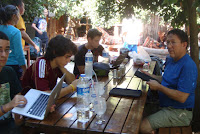Pompeii, located in the shadow of Mt. Vesuvius, was a prosperous town. It had been dormant longer than any humans remembered - no history of its destructive nature had survived. Prior to its devastating eruption, there had been a violent day filled with earthquakes, but that was 17 years earlier and while buildings and homes were still being repaired, life had returned to normal for the community of Pompeii.
It began with earthquakes, small, seemingly insignificant and people ignored them. Then the calm sea turned into giant waves but still, it didn't bring a warning. Finally, the volcano burst, spewing smoke, mud, flames and burning stones with a rain of ash and rock spread throughout the area, swallowing farms, orchards and villas.
People fled their homes while others locked themselves inside rooms, hoping to keep the ash out. Between the excessive heat and fumes of poisonous gases, the people of the city were killed. By the end of the day, the town of Pompeii was covered in a layer of debri 30 feet thick.
While small things had been found over time, it wasn't until the late 1700's that excavation of the area began. It is startling to realize how organized, how "civilized", cities at that period of history could be. The streets were paved, with stepping stones so that one could walk across the street without stepping into puddles or dirt that could have been tracked by a horse. The roads had proper sidewalks that you could walk along. Along the streets there were stores, sometimes homes that sold something from their front porch. The bakers had ovens, grinders, carts for hauling the bread. And the counters - they're fabulous, made out of marble. They even have holes with warming areas underneath to keep the food they were selling hot!

 There were some common elements to the homes in Pompeii. From the entranceway, the visitor would enter into an atrium where there would be a small pool to catch rainwater. Sometimes these were outside in a garden area, such as the picture here with the faun or they might be inside the house with a hole in the roof above it. Many of the houses would have a small garden in back, though some of the larger homes could have quite extensive gardens. The other rooms of the house would open up onto the atrium or areas surrounding the garden type area.
There were some common elements to the homes in Pompeii. From the entranceway, the visitor would enter into an atrium where there would be a small pool to catch rainwater. Sometimes these were outside in a garden area, such as the picture here with the faun or they might be inside the house with a hole in the roof above it. Many of the houses would have a small garden in back, though some of the larger homes could have quite extensive gardens. The other rooms of the house would open up onto the atrium or areas surrounding the garden type area. Some of the homes have beautiful paintings on the walls, many of them quite well preserved. The paintings were apparently used the way we hang pictures. Many homes had mosaics in the entrance way, other outside areas or covering the floors of their homes and some are quite well preserved.
Some of the homes have beautiful paintings on the walls, many of them quite well preserved. The paintings were apparently used the way we hang pictures. Many homes had mosaics in the entrance way, other outside areas or covering the floors of their homes and some are quite well preserved.















































